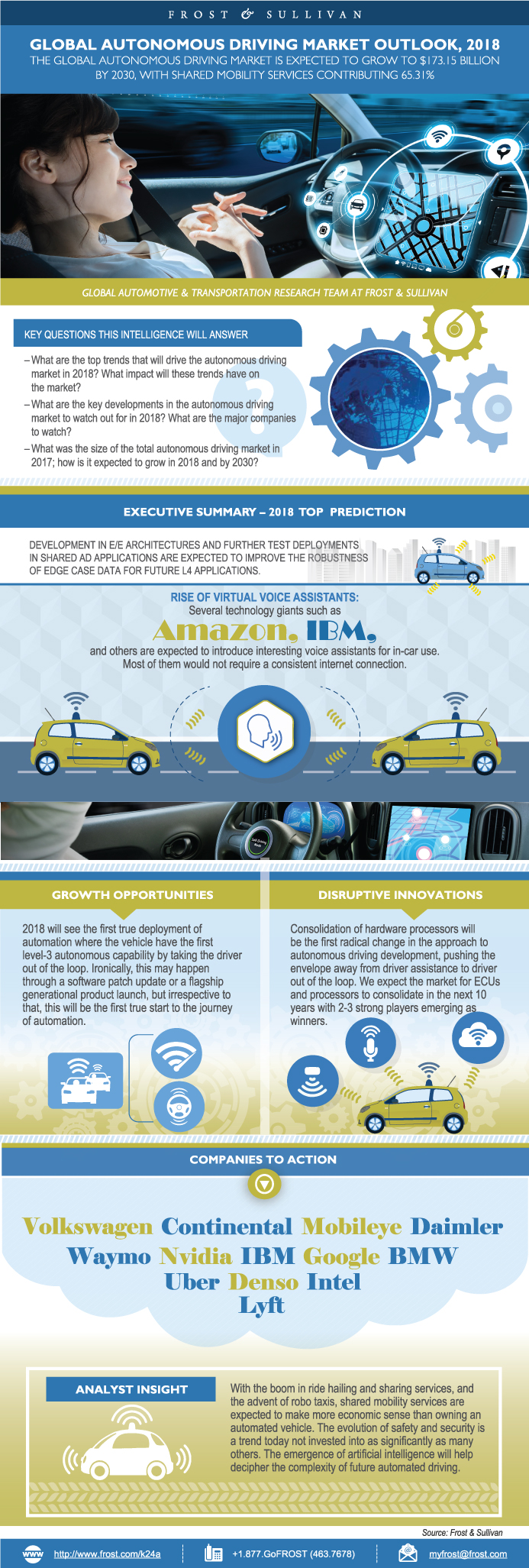Global Autonomous Driving Market Outlook, 2018
Global Autonomous Driving Market Outlook, 2018
The Global Autonomous Driving Market is Expected Grow up to $173.15 B by 2030, with Shared Mobility Services Contributing to 65.31%
15-Mar-2018
North America
$4,950.00
Special Price $3,712.50 save 25 %
Description
2018 will see the first true deployment of automation where the vehicle will tell the driver with the first level 3 (L3) autonomous capability by taking the driver out of the loop to be introduced next year. Ironically, this may happen through a software patch update or a flagship generational product launch. Regardless of the medium through which this happens, it will be the first true start to the journey of automation. Currently most major OEMs and tier 1 suppliers are looking at exploring the benefits of developing applications focused on the convergence of the three technology pillars: Connected, Autonomous, and Electric. However, the true potential of each of these technology pillars can be tapped only by the marriage of technology and service pillars of the industry. Within the service pillar, there are elements – firstly, the vehicle itself [leasing]; secondly, the services that can be leveraged by the vehicle [mobility]; and thirdly, data-driven services [IoT Platforms].
There is a growing need for improving vehicle perception capabilities, which will create opportunities for both existing sensors to proliferate as well as new sensing technologies to emerge. Bad and complex driving conditions are still not addressed by today's autonomous test systems and one of the keys to real-world deployment would be the improvement of visions applications. Within this growth of sensors per car, many OEMs will be finalizing their sensor suite by L3 and incrementally adding sensors to address other levels. For example, Tesla has already frozen its suite for L3 and L4 automation, while others are expected to have diverse sensor suite designs for fully autonomous and partial autonomous applications. There can possibly be no one winner in the autonomous race but the true possibility of tapping the potential on autonomous technology is by creating a strong ecosystem with the customer being at the center. For this, it will be essential to look outside of the value chain focused on service-centric solutions with a partnership-based value chain. Between now and the 2030 milestone, there are numerous hurdles, both quantitative and qualitative, that the industry will need to tackle if autonomous driving has to bring a long-lasting impact to make safe, clean, and lean transportation a reality. The biggest hurdle today though is the lack of clear regulatory frameworks that define the outlines of how these products can be made available to the consumers. Statistically, even in a mid scenario, where autonomous emergency braking is mandated before 2020 and fully autonomous technology is made available commercially in the next decade, it will take more than 25 years from then to bring road fatalities to zero.
RESEARCH: INFOGRAPHIC
This infographic presents a brief overview of the research, and highlights the key topics discussed in it.Click image to view it in full size

Table of Contents
2017 Key Highlights
2018–2019 Top-of-Mind Issues for Senior Management
Leading Players in terms of AD Patents Filed in 2017
Sensors Currently Used Across Applications
Next Generations of Sensor Fusion
Future Approach in Hardware and Software toward L5 Automation
Level 3 Automated Vehicles—What could be new?
2018 Top 5 Predictions
Research Scope
Vehicle Segmentation
Market Definition—Rise of Automation
Key Questions this Study will Answer
Transformational Impact of Automation on the Industry
Impact on the Development of Next-Generation Depth Sensing
Impact on Ownership and User-ship Structures
Impact of Autonomous Driving on Future Vehicle Design
Impact of Investments on Technology Development
Top Trends Driving the Autonomous Driving Market—2018
1. Autonomous Shared Mobility Solutions
Case Study—Waymo
2. Collective Intelligence for Fleet Management
Case Study—BestMile
3. Cyber Security of Autonomous Cars
Case Study—Karamba Security
1. Convergence of Artificial Intelligence and Automated Driving
Case Study—Mobileye
2. Domain Controllers
Case Study—Audi zFAS (zentrale Fahrerassistenzsteuergerät )
3. Driver Monitoring System
Case Study—General Motors’ Driver Attention System
Feature Roadmap—Autonomous Driving
Major OEM Outlook—1: Global
Major OEM Outlook—2: Global
Autonomous Shared Mobility—Competition Landscape
Technology Enablers and Major Suppliers
Region-wise Estimation of AD Unit Shipments—Market Leaders
Region-wise Estimation of AD Unit Shipments—Market Followers
Total Market Size Autonomous Vehicles (Ownership)
Automated Driving—Shared Mobility: Taxi, By Rides
Automated Driving—Shared Mobility: Shuttles, By Rides
Frost & Sullivan's Key Criteria to Shortlist Companies
Capabilities of Shortlisted Start-ups—ADAS Sensors
Capabilities of Shortlisted Start-ups—Computer Vision Software
Capabilities of Shortlisted Start-ups—Other Systems
European Automated Market—Overview
North American Automated Market—Overview
APAC (China and Japan) Automated Market—Overview
Transformation in Autonomous Driving Ecosystem—2018
Growth Opportunity—Investments and Partnerships From OEMs/TSPs
Strategic Imperatives for Success and Growth
The Last Word—Three Big Predictions
Legal Disclaimer
List of Exhibits
List of Exhibits (continued)
List of Exhibits (continued)
List of Exhibits (continued)
The Frost & Sullivan Story
Value Proposition—Future of Your Company & Career
Global Perspective
Industry Convergence
360º Research Perspective
Implementation Excellence
Our Blue Ocean Strategy
Popular Topics
| No Index | No |
|---|---|
| Podcast | No |
| Author | Anirudh Venkitaraman |
| Industries | Automotive |
| WIP Number | K24A-01-00-00-00 |
| Is Prebook | No |
| GPS Codes | 9673-A6,9674-A6,9694,9800-A6,9807-A6,9813-A6,9968-A6,9AF6-A6,9B07-C1,9B13-A6,9B15-A6 |
 USD
USD GBP
GBP CNY
CNY EUR
EUR INR
INR JPY
JPY MYR
MYR ZAR
ZAR KRW
KRW THB
THB